Ginger
Ginger (Zingiber officinale) is a flowering plant whose rhizome, ginger root or ginger, is widely used as a spice and a folk medicine.[2] It is a herbaceous perennial which grows annual pseudostems (false stems made of the rolled bases of leaves) about one meter tall bearing narrow leaf blades. The inflorescences bear flowers having pale yellow petals with purple edges, and arise directly from the rhizome on separate shoots.[3]
| Ginger | |
|---|---|
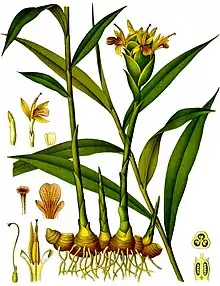 | |
| 1896 color plate from Köhler's Medicinal Plants | |
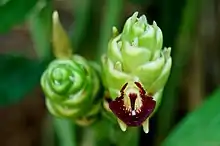 | |
| Inflorescence | |
| Scientific classification | |
| Kingdom: | Plantae |
| Clade: | Tracheophytes |
| Clade: | Angiosperms |
| Clade: | Monocots |
| Clade: | Commelinids |
| Order: | Zingiberales |
| Family: | Zingiberaceae |
| Genus: | Zingiber |
| Species: | Z. officinale |
| Binomial name | |
| Zingiber officinale | |
Ginger is in the family Zingiberaceae, which also includes turmeric (Curcuma longa),[4] cardamom (Elettaria cardamomum), and galangal. Ginger originated in Maritime Southeast Asia and was likely domesticated first by the Austronesian peoples. It was transported with them throughout the Indo-Pacific during the Austronesian expansion (c. 5,000 BP), reaching as far as Hawaii. Ginger is one of the first spices to have been exported from Asia, arriving in Europe with the spice trade, and was used by ancient Greeks and Romans.[5] The distantly related dicots in the genus Asarum are commonly called wild ginger because of their similar taste. In 2018, world production of ginger was 2.8 million tonnes, led by India with 32% of the world total.
Etymology
The English origin of the word "ginger" is from the mid-14th century, from Old English gingifer, from Medieval Latin gingiber, from Greek zingiberis, from Prakrit (Middle Indic) singabera, from Sanskrit srngaveram. The Sanskrit word is thought to come from a Dravidian word that also produced the Malayalam name inchi-ver (from inchi "root"),[6][7] an alternative explanation is that the Sanskrit word comes from srngam "horn" and vera- "body" (describing the shape of its root), but that may be folk etymology.[7] The word probably was readopted in Middle English from Old French gingibre (modern French gingembre).[6]
Origin and distribution
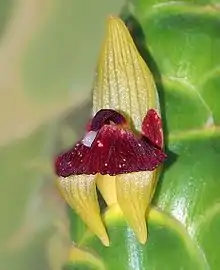
Ginger originated from Maritime Southeast Asia. It is a true cultigen and does not exist in its wild state.[8][9] The most ancient evidence of its domestication is among the Austronesian peoples where it was among several species of ginger cultivated and exploited since ancient times. They cultivated other gingers including turmeric (Curcuma longa), white turmeric (Curcuma zedoaria), and bitter ginger (Zingiber zerumbet). The rhizomes and the leaves were used to flavor food or eaten directly. The leaves were also used to weave mats. Aside from these uses, ginger had religious significance among Austronesians, being used in rituals for healing and for asking protection from spirits. It was also used in the blessing of Austronesian ships.[10][11][12][13][14][15]
Ginger was carried with them in their voyages as canoe plants during the Austronesian expansion, starting from around 5,000 BP. They introduced it to the Pacific Islands in prehistory, long before any contact with other civilizations. Reflexes of the Proto-Malayo-Polynesian word *laqia are still found in Austronesian languages all the way to Hawaii.[12] They also presumably introduced it to India along with other Southeast Asian food plants and Austronesian sailing technologies, during early contact by Austronesian sailors with the Dravidian-speaking peoples of Sri Lanka and South India at around 3,500 BP.[10][14][16] It was also carried by Austronesian voyagers into Madagascar and the Comoros in the 1st millennium CE.[17]
From India, it was carried by traders into the Middle East and the Mediterranean by around the 1st century CE. It was primarily grown in southern India and the Greater Sunda Islands during the spice trade, along with peppers, cloves, and numerous other spices.[9][18]
History
The first written record of ginger comes from the Analects of Confucius, written in China during the Warring States period (475–221 BC).[19] In it, Confucius was said to eat ginger with every meal.[19] In 406 AD, the monk Faxian wrote that ginger was grown in pots and carried on Chinese ships to prevent scurvy.[19] During the Song Dynasty (960–1279), ginger was being imported into China from southern countries.[19]
Ginger was introduced to the Mediterranean by the Arabs, and described by writers like Dioscorides (40–90 AD) and Pliny the Elder (24–79 AD).[19] In 150 AD, Ptolemy noted that ginger was produced in Ceylon (Sri Lanka).[19] Raw and preserved ginger was imported into Europe during the Middle Ages. In 14th century England, a pound of ginger cost as much as a sheep.[19]
Horticulture
Ginger produces clusters of white and pink flower buds that bloom into yellow flowers. Because of its aesthetic appeal and the adaptation of the plant to warm climates, it is often used as landscaping around subtropical homes. It is a perennial reed-like plant with annual leafy stems, about a meter (3 to 4 feet) tall. Traditionally, the rhizome is gathered when the stalk withers; it is immediately scalded, or washed and scraped, to kill it and prevent sprouting. The fragrant perisperm of the Zingiberaceae is used as sweetmeats by Bantu, and also as a condiment and sialagogue.[20]
Production
In 2018, global production of ginger was 2.8 million tonnes, led by India with 32% of the world total. China, Nigeria, and Nepal also had substantial production.[21]
| Ginger production, 2018 | ||||
|---|---|---|---|---|
| Country | Production (tonnes) | |||
|
Source: Food and Agricultural Organization of the United Nations, Statistics Division (FAOSTAT)[21] | ||||
Production in India
Though it is grown in many areas across the globe, ginger is "among the earliest recorded spices to be cultivated and exported from southwest India".[22] India holds the seventh position in ginger export worldwide, however is the "largest producer of ginger in the world".[23] Regions in southwest and Northeast India are most suitable for ginger production due to their warm and humid climate, average rainfall and land space.[24]
Ginger has the ability to grow in a wide variety of land types and areas, however is best produced when grown in a warm, humid environment, at an elevation between 300 and 900m, and in well-drained soils at least 30 cm deep.[25] A period of low rainfall prior to growing and well-distributed rainfall during growing are also essential for the ginger to thrive well in the soil.[26]
Ginger produced in India is most often farmed through homestead farming.[27] Since most ginger crops are produced on homestead farms, the farm employees are mostly family members or other local members of the community. Gendered roles within ginger farming are distributed quite evenly and fairly.[28] From land preparation to seed storage, all works of ginger cultivation in India are generally done by both female and male farmers.[28] Male farmers are widely known as the ones who purchase seeds, do the ploughing, and mulching, while female farmers usually do weeding and both genders share the work of hoeing, digging, planting, manure application, and harvesting.[29] This being said, since these farms are family run the distribution of work is more dependent on the family situation rather than gender. For example, if there are more men in the family then there would be more men working on the farm, but if there are an equal number of men and women, or less men than woman then there would be more women seen working on the farm.[28] Who does the selling of the ginger varies throughout different cities and states in India. In Meghalaya, Mizoram, and Nagaland (all in the Northeast of India) woman are important benefactors in the sale of ginger, but in Sikkim which is also in the Northeast region, men play a larger role than women do in the sale of ginger.[28]
Ginger farming
The size of the seed ginger, called rhizome, is essential to the production of ginger. The larger the rhizome piece, the faster ginger will be produced and therefore the faster it will be sold onto the market.[30] Prior to planting the seed rhizomes, farmers are required to treat the seeds to prevent seed-borne pathogens and pests, rhizome rot and other seed-borne diseases.[30] There are various ways farmers do seed treatment in India. These include dipping the seeds in cow dung emulsion, smoking the seeds before storage, or hot water treatment.[30]
Once the seeds are properly treated, the farm land in which they are to be planted must be thoroughly dug or ploughed by the farmer to break up the soil.[30] After the soil is sufficiently ploughed at least 3-5 times, water channels are made 60–80 ft apart to irrigate the crop.[30]
The next step after farmers ensure soil is well suitable for planting and growing is planting the rhizome seed. In India, planting the irrigated ginger crop is usually done in the months between March and June as those months account for the beginning of the monsoon, or rainy and season.[30] Once the planting stage is done, farmers go on to mulch the crop to “conserve moisture and check weed growth”, as well as check surface run-off to conserve soil.[31] Mulching is done by applying mulch (green leaves for example) to the plant beds directly after planting and again 45 and 90 days into growth.[30] After mulching comes hilling, which is the stirring and breaking up of soil to check weed growth, break the firmness of the soil from rain, and conserve soil moisture.[30] Farmers must ensure that their ginger crops are receiving supplemental irrigation if rainfall is low in their region. In India, farmers must irrigate their ginger crops every two weeks at the least between September and November (when the monsoon is over) to ensure maximum yield and high quality product.[30]
The final farming stage for ginger is the harvesting stage and for items such as vegetable, soda, and candy, harvesting should be done between four and five months of planting, whereas when the rhizome is planted for products such as dried ginger or ginger oil, harvesting must be done eight to ten months after planting.[30]
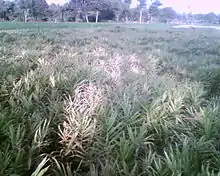
Dry ginger, one of the most popular forms of ginger commercially exported, must undergo drying and preparation to reach the goal product.[32] Ginger rhizomes that are to be converted into dry ginger must be harvested at full maturity (8–10 months), then they must be soaked overnight and rubbed well for cleaning.[32] After being removed from water the outer skin is very delicately scraped off with a bamboo splinter or wooden knife and this process must be done by hand as it is too delicate a process to be done by machinery.[32] After being traded internationally, dried ginger is ground in the consuming centres to which they arrive.[33] Fresh ginger, another very popular form of exported ginger is not required to undergo further processing after being harvested, and can be harvested much sooner than dry ginger.[33]
Transportation and export of ginger
Ginger is sent through various stages to be transported to its final destination either domestically or internationally, and the journey begins when farmers sell a portion of their produce to village traders who collect produce right at the farm gate.[33] Once the produce is collected, it is transported to the closest assembly market where it is then taken to main regional or district level marketing centres.[33] Farmers with a large yield of produce will directly take their produce to the local or regional markets. Once the produce has "reached [the] regional level markets, they are cleaned, graded, and packed in sacks of about 60kg".[33] They are then moved to terminal markets such as in New Delhi, Kochi, and Bombay.[33]
States in which ginger is exported follow the marketing channels of vegetable marketing in India, and the steps are similar to those when transported domestically. However, instead of reaching a terminal market after the regional forwarding centres, the produce will reach an export market and be sent off by vehicle, plane or boat to reach its final international destination where it will arrive to a local retail market and finally reach the consumer once purchased.[33]
Dry ginger is most popularly traded between Asian countries through a unique distribution system involving a network of small retail outlets.[33] Fresh and preserved ginger are often sold directly to supermarket chains, and in some countries fresh ginger is seen exclusively in small shops unique to certain ethnic communities.[33] India often exports their ginger and other vegetable produce very frequently to Pakistan and Bangladesh, as well as “Saudi Arabia, the United Arab Emirates, Morocco, the United States, Yemen Republic, the United Kingdom, and Netherlands”.[33]
Though India is the largest ginger producer in the world, it fails to play the role of a large exporter and only accounts for about 1.17% of total ginger exports.[33] Ginger farming in India is a costly and risky business, as they do not gain much money from exports and "more than 65 % of the total cost incurred is toward labor and seed material purchase".[33] The farm owner may benefit given that there is no losses in production or price decreases, which is not easily avoidable.[33] Production of dry ginger proves to have a higher benefit-cost ratio, as well as ginger cultivated in intercropping systems rather than as a pure crop.[33]
Uses

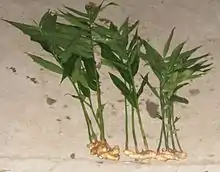
Ginger is a very popular spice used worldwide; whether it be used to spice up meals, or as a medicine, the demand for ginger all over the world has been consistent throughout history.[34] Ginger can be used for a variety of food or medicine items such as vegetables, candy, soda, pickles, and alcoholic beverages.[30]
Ginger is a fragrant kitchen spice.[5] Young ginger rhizomes are juicy and fleshy with a mild taste. They are often pickled in vinegar or sherry as a snack or cooked as an ingredient in many dishes. They can be steeped in boiling water to make ginger herb tea, to which honey may be added. Ginger can be made into candy or ginger wine.
Mature ginger rhizomes are fibrous and nearly dry. The juice from ginger roots is often used as a seasoning in Indian recipes and is a common ingredient of Chinese, Korean, Japanese, Vietnamese, and many South Asian cuisines for flavoring dishes such as seafood, meat, and vegetarian dishes.
Fresh ginger can be substituted for ground ginger at a ratio of six to one, although the flavors of fresh and dried ginger are somewhat different. Powdered dry ginger root is typically used as a flavoring for recipes such as gingerbread, cookies, crackers and cakes, ginger ale, and ginger beer. Candied ginger or crystallized ginger, known in the UK as "stem ginger", is the root cooked in sugar until soft, and is a type of confectionery. Fresh ginger may be peeled before eating. For longer-term storage, the ginger can be placed in a plastic bag and refrigerated or frozen.
Regional uses
In Indian cuisine, ginger is a key ingredient, especially in thicker gravies, as well as in many other dishes, both vegetarian and meat-based. Ginger has a role in traditional Ayurvedic medicine. It is an ingredient in traditional Indian drinks, both cold and hot, including spiced masala chai. Fresh ginger is one of the main spices used for making pulse and lentil curries and other vegetable preparations. Fresh ginger together with peeled garlic cloves is crushed or ground to form ginger garlic masala. Fresh, as well as dried, ginger is used to spice tea and coffee, especially in winter. In south India, "sambharam" is a summer yogurt drink made with ginger as a key ingredient, along with green chillies, salt and curry leaves. Ginger powder is used in food preparations intended primarily for pregnant or nursing women, the most popular one being katlu, which is a mixture of gum resin, ghee, nuts, and sugar. Ginger is also consumed in candied and pickled form. In Japan, ginger is pickled to make beni shōga and gari or grated and used raw on tofu or noodles. It is made into a candy called shoga no sato zuke. In the traditional Korean kimchi, ginger is either finely minced or just juiced to avoid the fibrous texture and added to the ingredients of the spicy paste just before the fermenting process.
In Burma, ginger is called gyin. It is widely used in cooking and as a main ingredient in traditional medicines. It is consumed as a salad dish called gyin-thot, which consists of shredded ginger preserved in oil, with a variety of nuts and seeds. In Thailand' where it is called ขิง khing, it is used to make a ginger garlic paste in cooking. In Indonesia, a beverage called wedang jahe is made from ginger and palm sugar. Indonesians also use ground ginger root, called jahe, as a common ingredient in local recipes. In Malaysia, ginger is called halia and used in many kinds of dishes, especially soups. Called luya in the Philippines, ginger is a common ingredient in local dishes and is brewed as a tea called salabat.[35][36] In Vietnam, the fresh leaves, finely chopped, can be added to shrimp-and-yam soup (canh khoai mỡ) as a top garnish and spice to add a much subtler flavor of ginger than the chopped root. In China, sliced or whole ginger root is often paired with savory dishes such as fish, and chopped ginger root is commonly paired with meat, when it is cooked. Candied ginger is sometimes a component of Chinese candy boxes, and a herbal tea can be prepared from ginger. Raw ginger juice can be used to set milk and make a desert, ginger milk curd.
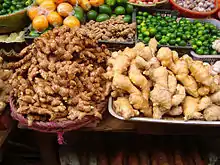
In the Caribbean, ginger is a popular spice for cooking and for making drinks such as sorrel, a drink made during the Christmas season. Jamaicans make ginger beer both as a carbonated beverage and also fresh in their homes. Ginger tea is often made from fresh ginger, as well as the famous regional specialty Jamaican ginger cake. On the island of Corfu, Greece, a traditional drink called τσιτσιμπύρα (tsitsibira), a type of ginger beer, is made. The people of Corfu and the rest of the Ionian islands adopted the drink from the British, during the period of the United States of the Ionian Islands.
In Western cuisine, ginger is traditionally used mainly in sweet foods such as ginger ale, gingerbread, ginger snaps, parkin, and speculaas. A ginger-flavored liqueur called Canton is produced in Jarnac, France. Ginger wine is a ginger-flavored wine produced in the United Kingdom, traditionally sold in a green glass bottle. Ginger is also used as a spice added to hot coffee and tea.
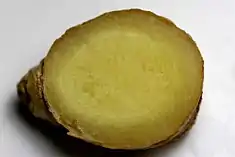 Ginger section | |
| Nutritional value per 100 g (3.5 oz) | |
|---|---|
| Energy | 333 kJ (80 kcal) |
17.77 g | |
| Sugars | 1.7 g |
| Dietary fiber | 2 g |
0.75 g | |
1.82 g | |
| Vitamins | Quantity %DV† |
| Thiamine (B1) | 2% 0.025 mg |
| Riboflavin (B2) | 3% 0.034 mg |
| Niacin (B3) | 5% 0.75 mg |
| Pantothenic acid (B5) | 4% 0.203 mg |
| Vitamin B6 | 12% 0.16 mg |
| Folate (B9) | 3% 11 μg |
| Vitamin C | 6% 5 mg |
| Vitamin E | 2% 0.26 mg |
| Minerals | Quantity %DV† |
| Calcium | 2% 16 mg |
| Iron | 5% 0.6 mg |
| Magnesium | 12% 43 mg |
| Manganese | 11% 0.229 mg |
| Phosphorus | 5% 34 mg |
| Potassium | 9% 415 mg |
| Sodium | 1% 13 mg |
| Zinc | 4% 0.34 mg |
| Other constituents | Quantity |
| Water | 79 g |
| |
| †Percentages are roughly approximated using US recommendations for adults. Source: USDA FoodData Central | |
Similar ingredients
Other members of the family Zingiberaceae are used in similar ways. They include the myoga (Zingiber mioga), the several types of galangal, the fingerroot (Boesenbergia rotunda), and the bitter ginger (Zingiber zerumbet).
A dicotyledonous native species of eastern North America, Asarum canadense, is also known as "wild ginger", and its root has similar aromatic properties, but it is not related to true ginger. The plant contains aristolochic acid, a carcinogenic compound.[37] The United States Food and Drug Administration warns that consumption of aristolochic acid-containing products is associated with "permanent kidney damage, sometimes resulting in kidney failure that has required kidney dialysis or kidney transplantation. In addition, some patients have developed certain types of cancers, most often occurring in the urinary tract."[37]
Nutritional information
Raw ginger is composed of 79% water, 18% carbohydrates, 2% protein, and 1% fat (table). In 100 grams (a standard amount used to compare with other foods), raw ginger supplies 80 Calories and contains moderate amounts of vitamin B6 (12% of the Daily Value, DV) and the dietary minerals, magnesium (12% DV) and manganese (11% DV), but otherwise is low in nutrient content (table).
When used as a spice powder in a common serving amount of one US tablespoon (5 grams), ground dried ginger (9% water) provides negligible content of essential nutrients, with the exception of manganese (70% DV).[38]
Composition and safety
If consumed in reasonable quantities, ginger has few negative side effects.[39] It is on the FDA's "generally recognized as safe" list,[40] though it does interact with some medications, including the anticoagulant drug warfarin[41] and the cardiovascular drug nifedipine.[2]
Chemistry
The characteristic fragrance and flavor of ginger result from volatile oils that compose 1-3% of the weight of fresh ginger, primarily consisting of zingerone, shogaols, and gingerols with [6]-gingerol (1-[4'-hydroxy-3'-methoxyphenyl]-5-hydroxy-3-decanone) as the major pungent compound.[42] Zingerone is produced from gingerols during drying, having lower pungency and a spicy-sweet aroma.[42] Shogaols are more pungent and have higher antioxidant activity but not found in raw ginger, but is formed from gingerols during heating, storage or via acidity.[42]
Fresh ginger also contains an enzyme zingibain which is a cysteine protease and has similar properties to rennet.
Research
Evidence that ginger helps alleviate nausea and vomiting resulting from chemotherapy or pregnancy is inconsistent.[2][43][44][45] There is no clear evidence of harm from taking ginger during pregnancy, but its safety is undefined.[43][46] Ginger is not effective for treating dysmenorrhea.[47] There is some evidence for it having an antiinflammatory effect, and improving digestive function but insufficient evidence for it affecting pain in osteoarthritis.[48][49]
Adverse effects
Allergic reactions to ginger generally result in a rash.[2] Although generally recognized as safe, ginger can cause heartburn and other side effects, particularly if taken in powdered form.[2] It may adversely affect individuals with gallstones, and may interfere with the effects of anticoagulants, such as warfarin or aspirin.[2]
Gallery
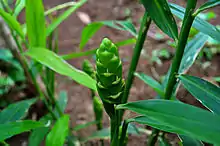 Ginger plant with flower
Ginger plant with flower Ginger flower about to bloom
Ginger flower about to bloom Ginger flower stamen
Ginger flower stamen Ginger crop, Myanmar
Ginger crop, Myanmar Chopped ginger
Chopped ginger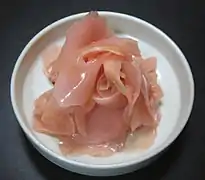 Gari, a type of pickled ginger
Gari, a type of pickled ginger German ginger-flavored wine (grape-based) with stem ginger decoration
German ginger-flavored wine (grape-based) with stem ginger decoration
References
- "Zingiber officinale". Germplasm Resources Information Network (GRIN). Agricultural Research Service (ARS), United States Department of Agriculture (USDA). Retrieved 10 December 2017.
- "Ginger, NCCIH Herbs at a Glance". US NCCIH. 1 September 2016. Retrieved 2 February 2019.
- Sutarno H, Hadad EA, Brink M (1999). "Zingiber officinale Roscoe". In De Guzman CC, Siemonsma JS (eds.). Plant resources of South-East Asia: no.13: Spices. Leiden (Netherlands): Backhuys Publishers. pp. 238–244.
- "Curcuma longa L." Plants of the World Online, Kew Science, Kew Gardens, Royal Botanic Gardens, Kew, England. 2018. Retrieved 26 March 2018.
- "Zingiber officinale Roscoe". Kew Science, Plants of the World Online. Royal Botanic Gardens, Kew. 2017. Retrieved 25 November 2017.
- Caldwell R (1 January 1998). A Comparative Grammar of the Dravidian Or South-Indian Family of Languages (3rd ed.). New Delhi: Asian Educational Services. ISBN 9788120601178.
- "Ginger". Online Etymology Dictionary. Douglas Harper. Retrieved 22 January 2011.
- Ravindran P, Nirmal Babu K (2016). Ginger: The Genus Zingiber. Boca Raton: CRC Press. p. 7. ISBN 9781420023367.
- Singh RJ (2011). Genetic Resources, Chromosome Engineering, and Crop Improvement. Medicinal Plants. 6. Boca Raton: CRC Press. p. 398. ISBN 9781420073867.
- Viestad A (2007). Where Flavor Was Born: Recipes and Culinary Travels Along the Indian Ocean Spice Route. San Francisco: Chronicle Books. p. 89. ISBN 9780811849654.
- Ross M (2008). "Other cultivated plants". In Ross M, Pawley A, Osmond M (eds.). The lexicon of Proto Oceanic: The culture and environment of ancestral Oceanic society. Vol. 3: Plants. Canberra: Pacific Linguistics. pp. 389–426. ISBN 9780858835894.
- Robert B, Trussel S (2013). "The Austronesian Comparative Dictionary: A Work in Progress". Ocean. Linguist. 52 (2): 493–523. doi:10.1353/ol.2013.0016. S2CID 146739541.
- Zanariah U, Nordin NI, Subramaniam T (2015). "Ginger Species and Their Traditional Uses in Modern Applications". Journal of Industrial Technology. 23 (1): 59–70. doi:10.21908/jit.2015.4.
- Dalby A (2002). Dangerous Tastes: The Story of Spices. University of California Press. ISBN 9780520236745.
- Kikusawa R, Reid LA (2007). "Proto who utilized turmeric, and how?" (PDF). In Siegel J, Lynch JD, Eades D (eds.). Language Description, History and Development: Linguistic indulgence in memory of Terry Crowley. John Benjamins Publishing Co. pp. 339–352. ISBN 9789027292940.
- Mahdi W (1999). "The Dispersal of Austronesian boat forms in the Indian Ocean". In Blench R, Spriggs M (eds.). Archaeology and Language III: Artefacts languages, and texts. One World Archaeology. 34. London: Routledge. pp. 144–179. ISBN 9780415518703.
- Beaujard P (2011). "The first migrants to Madagascar and their introduction of plants: linguistic and ethnological evidence" (PDF). Azania: Archaeological Research in Africa. 46 (2): 169–189. doi:10.1080/0067270X.2011.580142. S2CID 55763047.
- Doran CF, Dixon C (1991). South East Asia in the World-Economy. Cambridge: Cambridge University Press. ISBN 9780521312370.
- Pickersgill, Barbara (2005). Prance, Ghillean; Nesbitt, Mark (eds.). The Cultural History of Plants. Routledge. p. 163-164. ISBN 0415927463.
- Watt JM, Breyer-Brandwijk MG (1962). Medicinal and Poisonous Plants of Southern and Eastern Africa. E & S Livingstone.
- "Ginger production in 2018, Crops/Regions/World/Production/Quantity (from pick lists)". FAOSTAT. FAO, Statistics Division. 2019. Retrieved 22 May 2020.
- Münster, Daniel (1 March 2015). "Ginger is a gamble". Focaal. 2015 (71): 100–113. doi:10.3167/fcl.2015.710109. ISSN 0920-1297.
- Madan, M. S. (2016), "Production, Marketing, and Economics of Ginger", Ginger, CRC Press, pp. 444–477, doi:10.1201/9781420023367-16, ISBN 9781420023367
- Nair, Kodoth Prabhakaran (2019), "Ginger as a Spice and Flavorant", Turmeric (Curcuma longa L.) and Ginger (Zingiber officinale Rosc.) - World's Invaluable Medicinal Spices, Springer International Publishing, pp. 541–554, doi:10.1007/978-3-030-29189-1_26, ISBN 9783030291884
- Nybe, E.V. (2016), "Ginger Production in India and Other South Asian Countries", Ginger, CRC Press, pp. 224–253, doi:10.1201/9781420023367-9, ISBN 978-1-4200-2336-7
- Aryal, Suman (10 February 2013). "Rainfall And Water Requirement Of Rice During Growing Period". Journal of Agriculture and Environment. 13: 1–4. doi:10.3126/aej.v13i0.7576. ISSN 2091-1009.
- Nybe, E.V. (2016), "Ginger Production in India and Other South Asian Countries", Ginger, CRC Press, pp. 224–253, doi:10.1201/9781420023367-9, ISBN 9781420023367
- Pachuau, Lalduhsanga; Dutta, Rajat Subhra (11 September 2019), "Wild Edible Fruits of Northeast India: Medicinal Values and Traditional Practices", Herbal Medicine in India, Springer Singapore, pp. 437–450, doi:10.1007/978-981-13-7248-3_27, ISBN 978-981-13-7247-6
- Sneed, Christoper; Kwon, Theresa Hyunjin; Fairhurst, Ann (2017). "Do They Matter? The Impact of Atmospherics on Farmers' Market Consumers' Purchase Intention and Word-of-Mouth". Ames. doi:10.31274/itaa_proceedings-180814-389. Cite journal requires
|journal=(help) - Nair, Kodoth Prabhakaran (2019), "Ginger as a Spice and Flavorant", Turmeric (Curcuma longa L.) and Ginger (Zingiber officinale Rosc.) - World's Invaluable Medicinal Spices, Springer International Publishing, pp. 541–554, doi:10.1007/978-3-030-29189-1_26, ISBN 978-3-030-29188-4
- Carpenter, Philip (1975). "An Evaluation of Several Mulch Materials on Landscape Plant Growth, Weed Control, Soil Temperature and Soil Moisture : Interim Report". West Lafayette, IN. doi:10.5703/1288284313900. Cite journal requires
|journal=(help) - Balakrishnan, K.V. (2016), "Postharvest and Industrial Processing of Ginger", Ginger, CRC Press, pp. 401–443, doi:10.1201/9781420023367-15, ISBN 978-1-4200-2336-7
- Madan, M. S. (2016), "Production, Marketing, and Economics of Ginger", Ginger, CRC Press, pp. 444–477, doi:10.1201/9781420023367-16, ISBN 978-1-4200-2336-7
- Ravindran, P.N. (2016), "Introduction", Ginger, CRC Press, pp. 16–29, doi:10.1201/9781420023367-5, ISBN 9781420023367
- Hardon A, Boonmongkon P, Streefland P, et al. (2001). Applied health research manual: anthropology of health and health care (3rd ed.). Amsterdam: Het Spinhuis. ISBN 9789055891917.
- Co LL, Taguba YB (1984). Common medicinal plants of the Cordillera region (Northern Luzon, Philippines). Community Health Education, Services and Training in the Cordillera Region (CHESTCORE). ISBN 978-9718640005.
- "Aristolochic Acid: FDA Warns Consumers to Discontinue Use of Botanical Products that Contain Aristolochic Acid". US FDA. 11 April 2001. Archived from the original on 3 June 2017.
- "Nutrition facts for dried, ground ginger, serving size of one tablespoon, 5 grams (from pick list)". nutritiondata.self.com. Condé Nast. 2014. Retrieved 11 June 2017.
- Spinella M (2001). The Psychopharmacology of Herbal Medications: Plant Drugs That Alter Mind, Brain, and Behavior. MIT Press. pp. 272. ISBN 9780262692656.
- "Code of Federal Regulations, Title 21, Part 182, Sec. 182.20: Essential oils, oleoresins (solvent-free), and natural extractives (including distillates): Substances Generally Recognized As Safe". US FDA. 1 September 2014. Retrieved 21 December 2014.
- Shalansky S, Lynd L, Richardson K, et al. (2007). "Risk of warfarin-related bleeding events and supratherapeutic international normalized ratios associated with complementary and alternative medicine: a longitudinal analysis". Pharmacotherapy. 27 (9): 1237–47. doi:10.1592/phco.27.9.1237. PMID 17723077. S2CID 3905654.
- An K, Zhao D, Wang Z, et al. (2016). "Comparison of different drying methods on Chinese ginger (Zingiber officinale Roscoe): Changes in volatiles, chemical profile, antioxidant properties, and microstructure". Food Chem. 197 (Part B): 1292–300. doi:10.1016/j.foodchem.2015.11.033. PMID 26675871.
- Giacosa A, Morazzoni P, Bombardelli E, et al. (2015). "Can nausea and vomiting be treated with ginger extract?" (PDF). Eur. Rev. Med. Pharmacol. Sci. 19 (7): 1291–6. ISSN 1128-3602. PMID 25912592.
- Lee J, Oh H (2013). "Ginger as an antiemetic modality for chemotherapy-induced nausea and vomiting: A systematic review and meta-analysis". Oncol. Nurs. Forum. 40 (2): 163–170. doi:10.1188/13.onf.163-170. ISSN 0190-535X. PMID 23448741. S2CID 25066909.
- Matthews A, Haas DM, Mathúna DP, et al. (2015). "Interventions for nausea and vomiting in early pregnancy". Cochrane Database Syst. Rev. (9). CD007575. doi:10.1002/14651858.cd007575.pub4. PMC 4004939. PMID 26348534.
- Ernst E, Pittler MH (2000). "Efficacy of ginger for nausea and vomiting: a systematic review of randomized clinical trials". Br. J. Anaesth. 84 (3): 367–371. doi:10.1093/oxfordjournals.bja.a013442. PMID 10793599.
- Pattanittum P, Kunyanone N, Brown J, et al. (2016). "Dietary supplements for dysmenorrhoea". Cochrane Database Syst. Rev. 3 (3). CD002124. doi:10.1002/14651858.CD002124.pub2. PMC 7387104. PMID 27000311.
- Terry R, Posadzki P, Watson LK, et al. (2011). "The use of ginger (Zingiber officinale) for the treatment of pain: A systematic review of clinical trials". Pain Medicine. 12 (12): 1808–18. doi:10.1111/j.1526-4637.2011.01261.x. PMID 22054010.
- Anh, N. H.; Kim, S. J.; Long, N. P.; Min, J. E.; Yoon, Y. C.; Lee, E. G.; Kim, M.; Kim, T. J.; Yang, Y. Y.; Son, E. Y.; Yoon, S. J.; Diem, N. C.; Kim, H. M.; Kwon, S. W. (6 January 2020). "Ginger on Human Health: A Comprehensive Systematic Review of 109 Randomized Controlled Trials". Nutrients. 12 (1): 157. doi:10.3390/nu12010157. PMC 7019938. PMID 31935866.
External links
 The dictionary definition of ginger at Wiktionary
The dictionary definition of ginger at Wiktionary Media related to Zingiber officinale at Wikimedia Commons
Media related to Zingiber officinale at Wikimedia Commons Data related to Zingiber officinale at Wikispecies
Data related to Zingiber officinale at Wikispecies- Zingiber officinale List of Chemicals (Dr. Duke's)